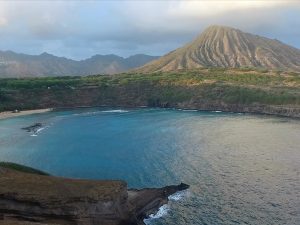Panel: A Place for Hawaiian Language in Conservation
0 Comments
[spb_tabs width=”1/1″ el_position=”first last”] [spb_tab title=”Part 1″ icon=”” id=”part1″] [spb_text_block pb_margin_bottom=”no” pb_border_bottom=”no” width=”1/1″ el_position=”first last”]
[/spb_text_block] [/spb_tab] [spb_tab title=”Part 2″ icon=”” id=”part2″] [spb_text_block pb_margin_bottom=”no” pb_border_bottom=”no” width=”1/1″ el_position=”first last”]
[/spb_text_block] [/spb_tab] [/spb_tabs] [fullwidth_text alt_background=”none” width=”1/1″ el_position=”first last”]
“Hawaiian language is the key that allows one access to the wealth of ancestral Hawaiian knowledge,” said Kainoa Pestana a conservationist who works at the Puʻu Kukui Watershed on Maui and a Hawaiian language speaker himself. His statements were widely supported by his fellow panelist, a group of Hawaiian language speakers who work in various areas of conservation in Hawaiʻi, as they sat on the first panel to be conducted completely in the Hawaiian language at the Hawaiʻi Conservation Conference held in July. It was a panel put together by Puaʻala Pascua, Kanoelani Steward, and Natalie Kurashima, young women who are invested in transforming Hawaiʻi’s conservation industry by encouraging the use of Hawaiian language, culture, and perspective. It was befitting in that this year 2019 was designated as the United Nation’s International Year of Indigenous Languages. You’ll find below a short video explaining the panel as well as the entire panel, split into two parts.
Organizers:
Puaʻala Pascua, Center for Biodiversity and Conservation, American Museum of Natural History
Kanoelani Steward, Nā Maka o Papahānaumokuākea/Ka Malu o Kahālāwai
Natalie Kurashima, Natural and Cultural Resources, Kamehameha SchoolsPanelist:
Kuʻulei Keakealani, Hui Aloha Kīholo & Kaʻūpūlehu Dryland forest
Noelani Puniwai, Kamakakūokalani Center for Hawaiian Studies
Lāhela Camara, Three Mountain Alliance
Noah Gomes, Kamehameha Schools
Kahiau Wallace, Kākoʻo ʻŌiwi
Kalani Quiocho, Papahānaumokuākea Marine National Monument
Pōmaika’i Kaniaupio-Crozier, Puʻu Kukui Watershed
Kainoa Pestana, Puʻu Kukui Watershed
[/fullwidth_text]
Puaʻala Pascua, Center for Biodiversity and Conservation, American Museum of Natural History
Kanoelani Steward, Nā Maka o Papahānaumokuākea/Ka Malu o Kahālāwai
Natalie Kurashima, Natural and Cultural Resources, Kamehameha SchoolsPanelist:
Kuʻulei Keakealani, Hui Aloha Kīholo & Kaʻūpūlehu Dryland forest
Noelani Puniwai, Kamakakūokalani Center for Hawaiian Studies
Lāhela Camara, Three Mountain Alliance
Noah Gomes, Kamehameha Schools
Kahiau Wallace, Kākoʻo ʻŌiwi
Kalani Quiocho, Papahānaumokuākea Marine National Monument
Pōmaika’i Kaniaupio-Crozier, Puʻu Kukui Watershed
Kainoa Pestana, Puʻu Kukui Watershed


